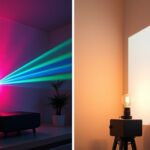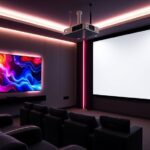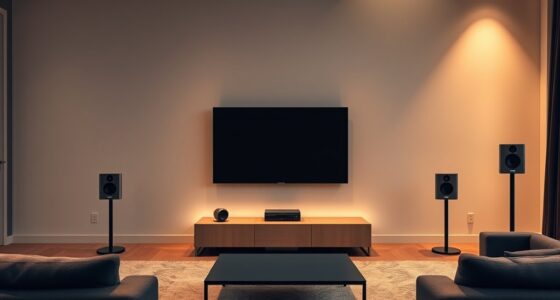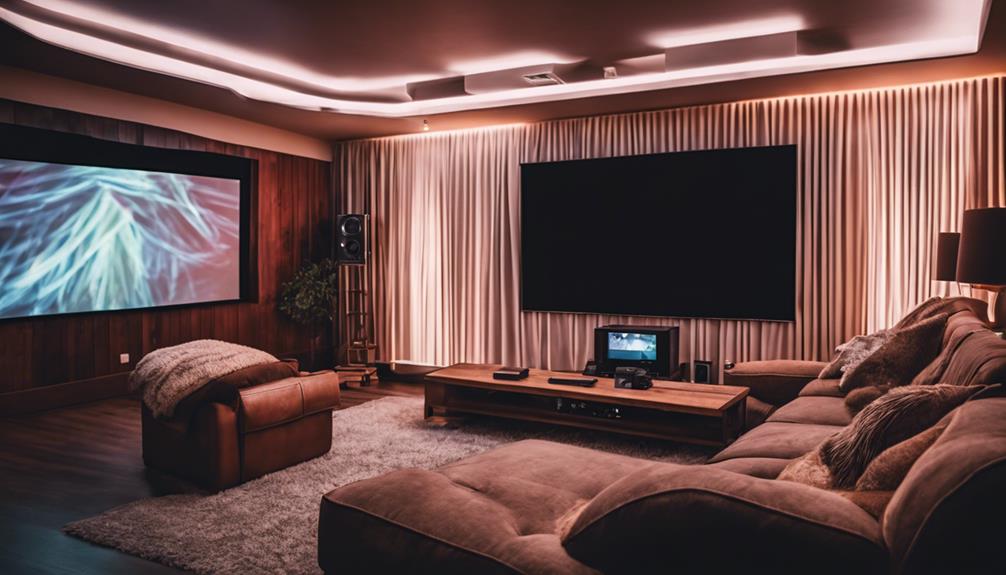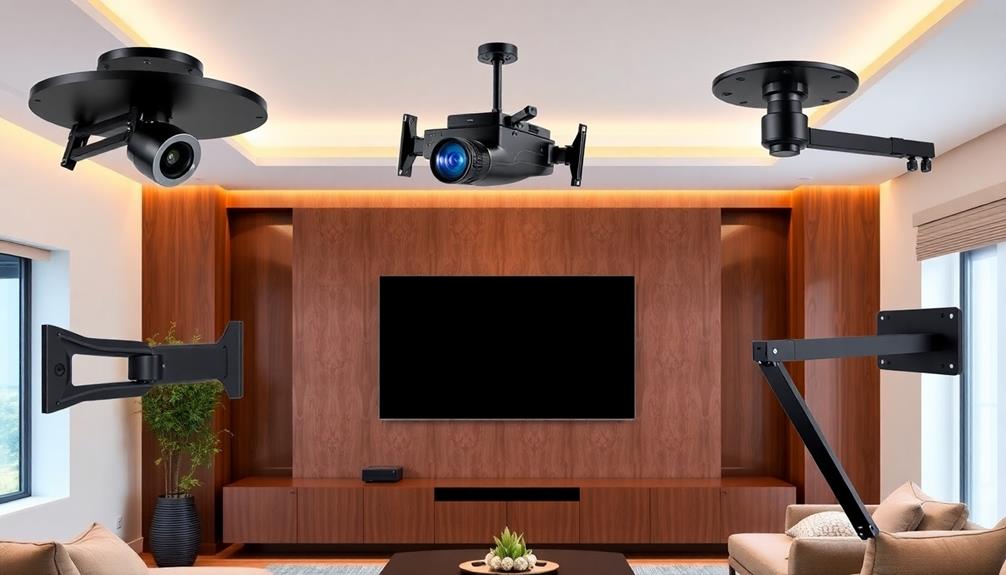For your home cinema, projectors are budget-friendly and flexible, fitting into existing spaces but require dark rooms and regular maintenance like bulb replacements. MicroLED video walls deliver stunning, seamless images with vibrant colors, lasting durability, and less ongoing upkeep, but come with a higher initial cost and more complex installation. If you’re willing to invest in quality and space modifications, MicroLED could be ideal; otherwise, projectors might suit your needs better. Discover more to find the best option for you.
Key Takeaways
- Projectors are more affordable upfront and flexible for existing spaces, while MicroLED walls require higher initial investment and structural modifications.
- MicroLED displays provide brighter, more vibrant images with minimal degradation, ideal for high-quality home cinema experiences.
- Projectors need dark rooms and proper placement for optimal image quality, whereas MicroLEDs perform well even with ambient light.
- MicroLED walls demand precise installation and calibration but offer lower long-term maintenance costs compared to projectors.
- The choice depends on available space, budget, and willingness to undertake complex installation versus ease of setup.
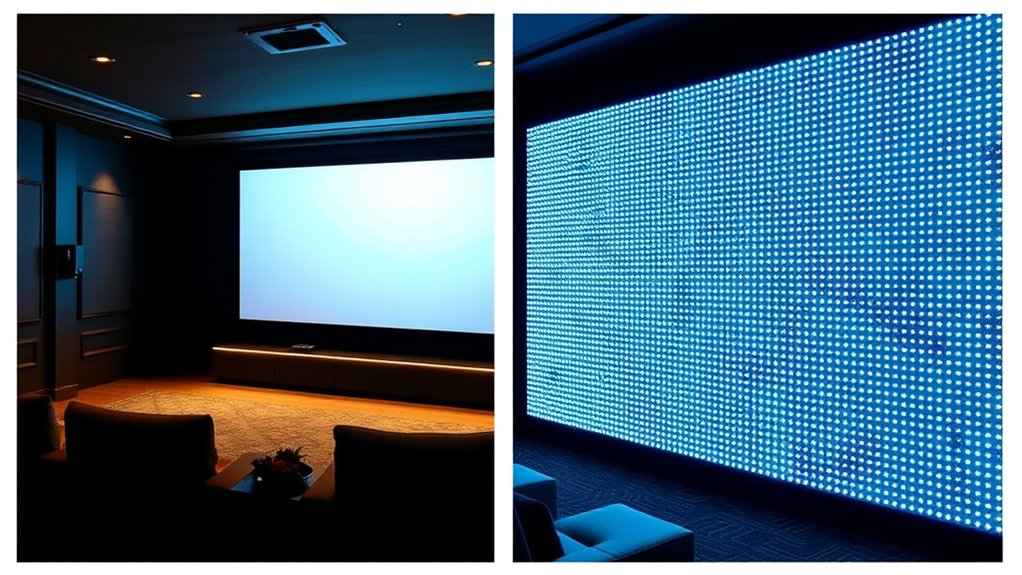
When choosing a large-format display solution, understanding the differences between projectors and MicroLED video walls is essential. If you’re setting up a home cinema, you’ll want to weigh the installation challenges and cost considerations carefully. Projectors are often seen as a more affordable option initially, but they come with specific installation hurdles. For example, achieving the ideal image quality requires proper mounting, screen placement, and sometimes a dedicated dark room to minimize ambient light interference. If you opt for a projector, you’ll need to consider the space’s dimensions and ensure you have enough distance for the throw ratio. Also, maintaining image clarity might require regular bulb replacements, which adds to ongoing costs. On the other hand, MicroLED video walls offer a more seamless, high-end experience but come with their own set of installation challenges. These displays require precise mounting and calibration to ensure uniformity across all panels, often necessitating professional installation. This process can be complex and time-consuming, especially if you’re trying to create a large, uninterrupted screen. The initial investment for a MicroLED setup is considerably higher than a projector, and that cost reflects not just the panels but also the installation labor and calibration needed to optimize the display. When comparing the two, consider how much you’re willing to invest upfront versus the long-term benefits. While projectors might seem more budget-friendly initially, they often require ongoing maintenance, replacement parts, and adjustments to keep the image sharp. MicroLEDs, although expensive at first, provide a brighter, more vibrant picture that doesn’t degrade over time, reducing long-term costs related to maintenance and replacements. The installation process for MicroLEDs can also be more invasive, sometimes demanding modifications to your existing structure or custom mounting solutions. In addition, advances in dream symbols and display technology continue to evolve, offering new options for immersive home cinemas. In contrast, projectors are typically easier to set up in existing spaces, provided you have the right throw distance and a suitable screen. Ultimately, your choice hinges on your budget, the space you’re working with, and how much effort you’re willing to invest in installation. If you prioritize a sleek, high-contrast display with minimal ongoing upkeep, a MicroLED video wall might be worth the higher initial cost and installation effort. Conversely, if you want a flexible, less invasive solution with lower upfront costs, a projector could be the better fit. Both options have their merits, so understanding these key differences helps you make an informed decision tailored to your home cinema dreams.
Frequently Asked Questions
How Do Maintenance Costs Compare Between Projectors and Microled Walls?
You’ll find that projectors generally have lower maintenance expenses and repair costs compared to microLED video walls. Projectors require occasional bulb replacements and filter cleaning, which are relatively affordable. In contrast, microLED walls involve higher repair costs due to their complex components and the difficulty of replacing individual LEDs. Overall, projectors tend to be more budget-friendly for ongoing maintenance, while microLEDs may demand more costly repairs over time.
Which Option Offers Better Scalability for Larger Home Theaters?
Scaling your home cinema is simpler with a MicroLED video wall. It overcomes scalability limitations and minimizes expansion challenges, allowing seamless size increases for larger spaces. Unlike projectors, which struggle with image quality and uniformity at bigger sizes, MicroLEDs deliver consistent brilliance and flexibility. So, if you dream of expanding effortlessly, a MicroLED wall offers better scalability, making your home theater truly spectacular as your space grows.
How Do Ambient Light Conditions Affect Image Quality?
Ambient light conditions considerably impact your home cinema experience. High ambient light sensitivity can reduce image clarity and color vibrancy, especially with projectors that are more prone to screen reflection issues. To get the best quality, you should control ambient light by dimming lights or using blackout curtains. MicroLED video walls handle ambient light better, providing consistent image quality even in brighter environments.
What Are the Installation Time Differences?
Installation time varies considerably between projectors and MicroLED video walls. Projectors typically have a quicker, simpler setup due to minimal equipment and straightforward mounting, reducing setup duration. MicroLED walls, however, involve complex installation, precise calibration, and extensive wiring, increasing installation complexity and lengthening setup duration. If you want rapid installation, a projector’s your best bet. For a seamless, integrated display, prepare for a longer, more involved MicroLED installation process.
Are There Health Concerns Related to Long-Term Microled Exposure?
Long-term microLED exposure generally isn’t a major health concern, but you should still be cautious about eye safety. MicroLED screens emit blue light, which can cause eye strain or discomfort over time. To protect yourself, take regular breaks and consider blue light filters or glasses. While microLED technology is safe when used properly, staying mindful of blue light exposure helps prevent potential eye fatigue or damage.
Conclusion
So, whether you settle for a classic projector or a flashy MicroLED video wall, remember that the perfect home cinema isn’t just about technology. It’s ironic—sometimes the biggest, brightest display can still leave you craving the charm of a simple projector’s cozy glow. After all, in the end, isn’t the real magic about how the screen makes you feel, not just how it looks? Choose what delights you most, and enjoy the show.


